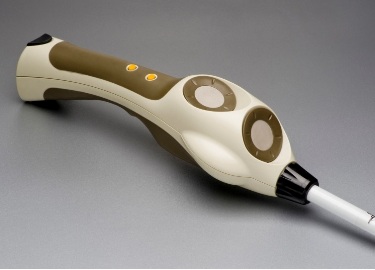For visually-impaired people, the simple task of walking down the street can be hazardous. Oncoming traffic, low-hanging branches or other obstacles can be dangerous or impede a person's ability to get around.
That's why the Ultrasound Research Interest Group developed a new state-of-the-art walking cane. Called UltraCane, the canes have the ability to warn the user if there is an obstacle ahead. The technology, founded at the University of Leeds, was modeled after bats and their ability to use sonic vibrations to 'see'. Bats emit ultrasonic pulses and then sense how long it takes for an echo to return. Similarly, this electronic mobility aide uses vibrations to alert users to oncoming objects. The handle of the cane is a handset-fitted with transmitters and sensors that can detect an obstruction in the user's path. Buttons on the cane's handle vibrate when the sensors detect an obstacle is near.

The UltraCane can gauge obstacles in several different ways. Through use of the dual-range narrow beam ultrasound system, the user can detect obstacles at head or chest levels. The cane has two button-shaped vibrators mounted in the handle. As the user approaches an object, the buttons vibrate, and the strength of the vibration indicates the proximity of the obstacle. In addition, the device can detect objects at either long- or short-range distances. The short-range mode detects objects within two meters of the handle. The long-range mode detects objects within four meters of the handle. And the upper transducer, designed for objects at head level, has a distance of 1.6 meters.
In order to make sure the cane was suited to a user's needs, the device was developed with a team of 20 vision-impaired volunteers. Then, it was tested in 2002 by vision-impaired people from Canada, America, Germany and the United Kingdom. Sound Foresight Technology Ltd. took over the development of the UltraCane in 2011. The device is available for individual users as well as mobility and rehabilitation therapists and experts. Each UltraCane comes with a user manual, which is available in Braille, along with an instructional exercises guide available online to the buyer. In addition, Sound Foresight Technology Ltd. hosts training programs to support the product.
The UltraCane is available in sizes ranging from 110 cm to 150 cm in 5 cm increments. Consumers are advised to buy the cane that is most similar in length to their current walking stick. Or, if they are not sure what size fits best, they should measure the length from their breastbone down to the ground. In addition, the company may be able to provide canes that are shorter than 110 cm or longer than 150 cm. UltraCane is distributed in Africa, Asia, Australia, Europe, North America, South America and the Middle East.
Lara Mossa Stump
and
Hulet Smith, OT